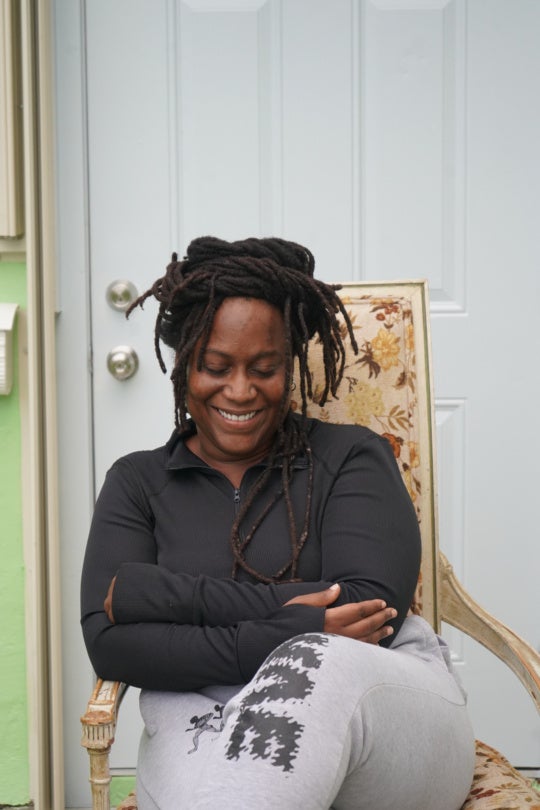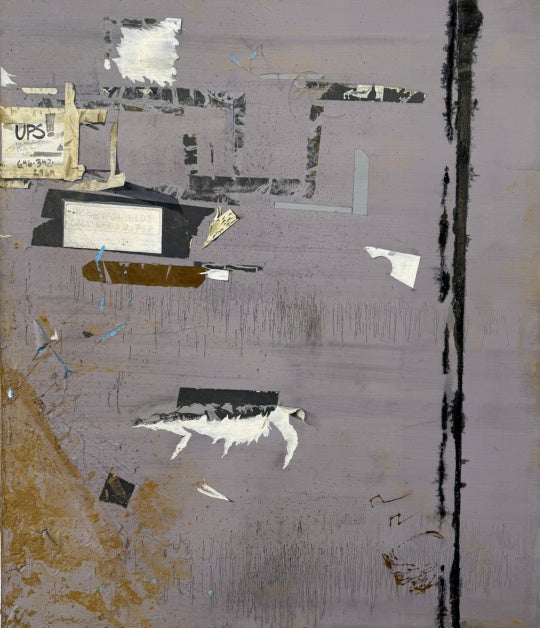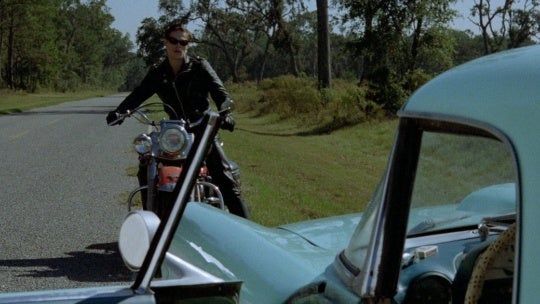
We met with Danielle Roney in her studio last May as she was finishing up a major commission and preparing to move to New York. She was working on a 40-foot-long table, with meticulous diagrams that plotted where the 12,000 ceramic beads were to be installed on stainless steel cables. Titled Aeon, the work resembles both biomorphic forms and 3-D digital modeling. Commissioned for Greenway Plaza in Houston, it is suspended from the ceiling and hangs down three levels, the beads creating a sense of fluidity and floating. Roney is also known for video installations and projections, some onto building facades. We talked about what informs her work, from science to migration and globalism.
Carl Rojas: Give us Danielle Roney in a nutshell.
Danielle Roney: My background is in sculpture and digital media and my practice is always a combination of the two. I’ve always been a technology person. Around 2000, when the information age really took off, I started investigating what the repercussions of that would be—socially, globally, and culturally. Around 2004, I wrote a project concept called Global Portals. It was about the networking of public spaces transnationally. The technology wasn’t there yet; it’s barely there now, actually. I was very interested in what Chantal Mouffe was writing about at the time: the political, social, and global implications of this upcoming pluralism. I was asking, what would the public realm be like? What was the future of public art through technology? Global Portals was my way of investigating those questions.
At the time, Ted Anderson had just bought TED and he was trying to expand it. Oxford University hosted the first TED global seminar that year. It was 2005. I wrote to TED about my project and explained why I thought they should invite me. It was still small, around 300 people, and they wanted to expand from the US to Europe and other places, but it was still an experiment. So I got invited to attend, and the night before I got on the plane, they called me and said they wanted fresh ideas integrated into 18-minute presentations, and he said “you’ve got three minutes, we’ll talk to you tomorrow.” I had never talked about the concept publicly.
SC: You didn’t think you’d be speaking at all?
DR: No! I thought I was invited to be part of the 300 in the room for the week. It was still very closed. It was very think-tank oriented at the time. I was completely shocked. It was curated in days or conversations like it is today. Clay Shirky went before me. He was introducing what Flickr would be. Jimmy Wales was after me, and he was explaining what Wikipedia was. It was an interesting context to put public art into.
After that, I spent some time really focused on these pluralistic modern centers. I did a series of exhibitions called Genesis Trial. I did an exhibition at the Atlanta Contemporary about Beijing. I had opened a second studio in Beijing. I spent about six months of the year working in Beijing and then the rest of the year working here.
SC: Why Beijing?
DR: I was interested in how far I could push the concept of global portals in a closed society. China was having a renaissance moment in contemporary art. It was just loosening up after this cultural revolution. It was an important moment in Chinese contemporary art. I was interested in participating in what was happening over there.

CR: But back to the three minutes …
DR: The three minutes was fine!
CR: Did you record it? Do you have it?
DR: I didn’t record it. I haven’t seen it. I’ve seen photos.
CR: Did people follow up with you? Did anybody ask questions?
DR: People did follow up. We were up until 2 a.m. every night. Everyone, no matter what field they came from, everyone was fascinating. It was non-stop. bout 15 people got three minutes each to talk. The ideas were extreme, so the big question was “How are you going to do that?” The technology wasn’t there. Everyone had their ideas but we—technology wise—were not there.
SC: Was that a pivotal moment in your career?
DR: I think it was the beginning of a conceptual moment. I think that was the importance of it. Everything I’ve pursued since then has a foundation there and has grown and responded to how our conditions have unfolded since those primary questions were asked. I’m still responding to that in different ways.
CR: Since 2005,you’ve tried to tie everything back to this notion of global portals?
DR: I think it has evolved. That’s always a fundamental point: How am I using technology to respond and reflect on the time in history that I’m living—as an artist on a global scale? I spent at least five years on that macro-global scale. I was responding to different megacities. We did live simulcasting from Johannesburg to the National Black Arts Festival [in Atlanta] in 2007. I had people working for me in Atlanta when I was in Johannesburg.
SC: Where did you go to school?
DR:I graduated from UGA in the late 1990s and then I moved to L.A.
SC: What made you move here? You’re not from Georgia, are you?
DR: No, I’m not. My father was the dean of an art school in North Carolina. I was freelancing and living in Miami after high school. My parents are both artists. When you’re young you want to find your own identity. I realized that being an artist was going to be my life. I asked my father for some advice on the best programs and he knew the dean of the UGA art school, who was an art historian. The faculty was implementing new programs at the time. He told me to drive to Athens, talk to a few people and see what I thought, that it might be the right fit for you. He was right. It was very good advice. It was the right place for me at the right time.
I was a sculptor first. They hired one professor from MIT. He really let me do my thing. We did an interdisciplinary studies program. We set our own parameters. I was already making digital videos and sculpting, but I knew I wanted that time-versus-space physical realm. That was where my sensibilities were at their best. I had to learn how to be a filmmaker—screenwriting, acting, directing, producing. I took a lot of comparative literature because I had flexibility since I placed ahead in math and science.
SC: Are your concepts around time/space more scientific or more performance arts, in a sense?
DR: Yes. I will be spending the rest of my life exploring this. It’s a mixture of both, but for me it is the science. I am a science person. I care about physics. I spend time with scientists.
SC: Why didn’t you pursue a career in science?
DR: I think I could have. I grew up in both of my parents’ studios. I went out into the world to see if I could work as a math or science person. I spent more of my time making art for myself than anything else. That’s when I realized I needed to grow and have my own identity. I’m a different artist than my parents. They’re academic practitioners. I was born in Syracuse in upstate New York. My dad was born in Niagara Falls and went to school for ceramics in Syracuse. My mom is from North Carolina. They met in North Carolina and that’s where I grew up.




